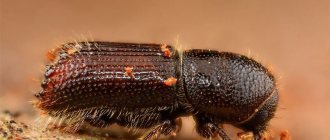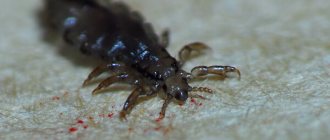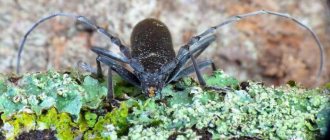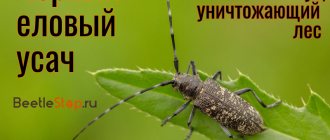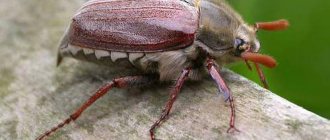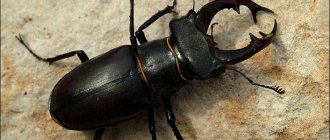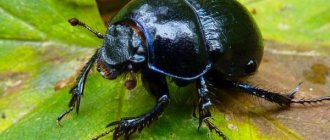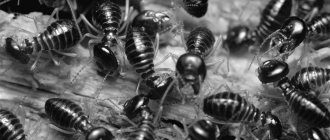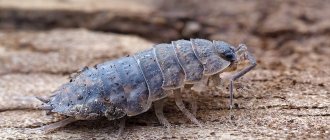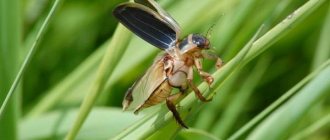Despite its small size, the bark beetle is capable of causing irreparable damage to forests and gardens in a short period of time, destroying huge tree stands. Its various species settle not only in living, but also in dead wood, turning it into dust and rendering building materials, wooden buildings, and furniture unusable. There are varieties of bark beetles that destroy food supplies.
- Where does he live?
- Characteristics and body structure Head
- Thoracic part
- Wings and elytra
- Limbs
- Abdomen
- Spruce beetle
- Larva
- Temperature method
To prevent a pest beetle invasion, you need to know what it looks like and what the danger of its appearance is. To combat the beetle and its offspring, the most effective methods should be used, as well as the necessary preventive measures.
Where does he live?
The main pests of forests - bark beetles - can be identified by their main feature - they feed on wood, raise offspring in it, overwinter and spend the main part of their life under the bark of a tree or in its nutritious part.
All types of bark beetles are herbivores. The main part of them are wood-eating insects, for which tree species are their habitat. These are mainly spruce, pine, birch, cedar, and larch trees, the bast tissue of which bark beetles feed on.
There are species of beetles of this subfamily that live in the fruits and seeds of tree species and herbaceous plants. They are usually representatives of tropical species.
The geographic distribution of bark beetles is directly related to the location of the tree species that feed them. Bark beetles live in different territorial zones, with climatic conditions characteristic of these zones. More often these are taiga areas, less often – steppes.
Preventive actions
- It is necessary to annually prune dry or diseased tree branches, because these beetles feel weak and tend to such plants.
- The boles should be painted with lime mortar in a timely manner.
- To combat larvae, you can use a coating of phosphorus and organic preparations; this should be done during the period of insect activity.
- For better absorption of chemicals, you can add grated laundry soap to them. Treat every 2-3 weeks.
- You can also use homemade “traps”: before the season, freshly cut tree trunks are laid out along the edges of the site; the beetles will most likely choose them for reproduction, after which these trees are burned without waiting for the young bark beetles to hatch from the pupae.
- Attracting birds or insects that will happily feast on a whole colony of parasites is also an excellent option for prevention.
Characteristics and body structure
Externally, bark beetles are very diverse. The appearance of the tree pest, the bark beetle, corresponds to the image and conditions of its life. But beetles also have common characteristics by which they are classified and belong to this subfamily. Color can range from light brown to black. The smallest bark beetles living in Russia have a body size of less than 1 mm, and their larger relatives reach 9 mm.
Head
Although the bark beetle is considered a close relative of the weevil, its head does not have a rostrum, like that of an elephant. It is a continuation of the body with a blunt forehead. The front of the head varies between sexes of the same species. The eyes are round and flat. The antennae are geniculate and short. The head is usually darker in color than the rest of the insect.
Thoracic part
There are three segments on the chest - on the upper side they are called anterior, mid, and posterior. From the bottom - prothorax, mid-thorax, metathorax. The most important is the pronotum, which can be: spherical, quadrangular, oval, triangular. Its lateral edges are slightly rounded, and there is a narrowing at the very top.
Dotted grooves are applied across the entire surface. The tubercles and denticles located on the pronotum are of specific importance. The triangular shield is strongly recessed and also covered with dotted lines.
Wings and elytra
The body of the bark beetle is covered with strong, well-developed elytra, under which are membranous wings necessary for the insect to fly. The wings cover the main part of the abdomen. An important difference between adult individuals is the characteristic notch on the back of the elytra. It is called a “wheelbarrow” and serves as a device for clearing passages of wood flour. The elytra have pronounced points in several rows.
Limbs
Thin paws are covered with sparse, hard hairs or have none at all. The hip part of the forelimbs is round, the hind limbs are transverse. On the flattened shins, tubercles protrude from the outer side. The front legs are short, the hind legs are longer.
Abdomen
The abdomen is located horizontally, consists of five rings, and is covered from the upper part by elytra. Females usually have a wider abdomen than males. There are organs for oviposition.
Species and family of bark beetles
Previously, these numerous pest beetles belonged to the bark beetle family (Scolytidae). In the present systematization, this group is considered a subfamily included in the family Weevils (Curculionidae), order Coleoptera.
There are 140 species of bark beetles distributed on the European continent. In total, science knows more than 750 species belonging to this subfamily. Bark beetles are part of the 4-jointed group (Tetramera), which also makes them close relatives of the most numerous pest beetles, weevils.
Spruce beetle
Another name for this bark beetle is the great spruce beetle. This is the largest bark beetle that lives in Russia. Its length varies from 5 to 9 mm. Specimens measuring 18.5 mm have been described.
Dendrocton inhabits the lower part of trunks and protruding roots of trees. Resin flows out of the hole made in the trunk, which, mixed with drill flour sharpened by the beetle, hardens in the shape of a funnel. From this you can understand that the tree was attacked by the spruce beetle.
The female Dendrocton, unlike other bark beetles, lays eggs not in separate chambers, but in one pile. Therefore, the larvae live and feed together. Only before pupation does each bark beetle larva make an individual cradle for itself.
Grinder
People call the grinder a pretender because of his behavior in case of danger. If something threatens the life of a beetle, it falls and does not move, pretending to be dead. There are three groups of grinders:
- furniture;
- home;
- powder.
The borer is a real scourge for the home, because it is difficult to list everything that the insatiable bark beetle feeds on. He eats almost everything. Grinder larvae are especially indiscriminate in their feeding. Any wood and all its derivatives are used. Cereals, tobacco, and any chemicals are also destroyed. At the same time, the beetles are not afraid of being poisoned and remain alive and unharmed. In summer, grinders live actively, and in winter they are dormant.
Birch sapwood
Since birch sapwood is oligophagous, it harms only one type of plant - birch trees, and is distributed in areas where various types of birch trees grow. Pests settle on dried, weakened and old trees. Construction blanks and birch firewood also serve as a home for beetles.
The main damage is caused by the larvae, damaging the bark, sapwood, bast, as well as young beetles, eating the bark around the buds during additional feeding. You can find out if a tree is infested with a bark beetle by the round holes located along the uterine duct. The beetle makes these holes for ventilation inside the passages.
Generation takes place in one year. The larvae remaining for the winter tolerate frosts down to -30 0 C. They pupate in the spring, and in May-June the young beetles begin their years.
Shashel
The shachel bark beetle is also known under the name “woodworm”. It affects the wooden structures of the house and the wooden furniture in it. You can understand that there is a woodworm in the house by two main signs:
- a characteristic sound reminiscent of a grinding sound - this is how the shawl larvae gnaw their passages with their strong jaws;
- through piles of brown flour, which is formed as a result of grinding wood by beetle larvae and pours out through the holes they make.
It is almost impossible to cure wood infected with the disease. You can find out about the damage too late, when the wood is literally crumbling before your eyes. It should be separated from the healthy part and burned along with the insects.
Longhorn beetle
The numerous species of longhorned beetle cannot be confused with other insects due to its main distinguishing feature - long segmented antennae, which can be 2-4 times longer than the body.
Longhorned beetles are found in all corners of the globe. This is due to their food supply, primarily tree species. That's why these beetles are called lumberjacks.
Representatives of longhorned beetles are very diverse in shape, color, size, and sculpture of the elytra. The beetle that poses a danger to the home can reach a length of up to 15-20 mm. Its female is capable of laying up to 400 eggs. To do this, she chooses the highest place to protect her offspring.
And after two weeks, larvae emerge from the eggs, capable of turning the tree into dust. During the day, the larva makes a burrow 15-30 mm long. After another 20 days, the larva pupates, and then a young woodcutter beetle appears.
wood beetle
The wood-boring beetle differs from other bark beetles in that it lays eggs exclusively in dead wood - building materials and wooden furniture. The woodworm looks like a small black or dark brown beetle, no larger than a match head, with thin wings.
The insect reproduces very quickly. With the onset of spring warmth, after mating, the female begins to lay eggs in all the cracks and crevices of the wood or makes passages herself, to a depth of several centimeters.
The wood-boring beetle gets into the house along with the affected wood. More often these are building materials or wooden furniture infested with a beetle. You can see the beetle itself at night - sometimes it flies out into the light. Or detect signs and traces of its vital activity - creaking in silence and wood dust near furniture.
Bark beetle typographer
It is also called the “large spruce bark beetle” - one of the most dangerous forest pests. He prefers different types of spruce to all conifers: Siberian, common, oriental, and Ayan. The main habitat of the bark beetle is considered to be coniferous plantations in Europe, Kazakhstan, Turkey, Siberia, the Far East, Sakhalin and Kamchatka.
It mainly affects trees that are weakened, diseased, broken, or already attacked by another beetle from the bark beetle subfamily, the chalcograph. Healthy spruce trees are able to independently resist the stem pest, producing the necessary amount of resin.
The typograph bark beetle has a brown-black, cylindrical body covered with small hairs. An adult beetle grows to 4.5-5.5 mm in length. It lives under the bark of the spruce tree, in the bast layer, on which it and its younger generation feed.
Ordinary engraver
The small-sized common engraver is found in mixed or coniferous forests. Prefers spruce and pine. Can settle on fir or larch. It affects young trees or the tops and young stems of old ones, as it can only gnaw through thin bark. Actively colonizes freshly prepared building materials.
The common engraver is easily recognized by its description:
- the body is 1.5-2 mm long, cylindrical in shape, dark brown or black in color with a glossy sheen;
- The wheelbarrow in males is edged with three spines on each side, in females - with small tubercles in the same number.
In addition to mechanical damage to wood, the engraver beetle causes damage by spreading fungus on trees - this can be seen by the blue color of the bark.
Reproduction
With the arrival of spring, when the air temperature reaches +10 0 C, the beetles begin to leave their wintering places. Males are the first to come to the surface, in search of a suitable tree for future offspring. The male penetrates under the bark of a tree and there builds a fairly spacious mating burrow. When everything is ready, the beetle begins to emit a special smell - a pheromone, to attract females. From 2 to 4 females fly to the smell.
After mating, the female goes to lay eggs, making her uterine passage in the bark, 8 to 16 cm long and 2-3 mm wide. On the way, she makes a side depression and places an egg in it. Seals the entrance with sawdust and continues working further. In total, the female is capable of laying, on average, up to 80 eggs.
The life cycle of the bark beetle includes 4 stages of development:
- egg – up to 2 weeks;
- larva – up to 3 weeks;
- pupa – a little more than 10 days;
- adult.
From the moment the egg is formed until the young beetle appears, about 60 days pass. It happens that the female has not yet finished laying the uterine duct, and the laid eggs are already moving into the larval stage.
Larva
Having been born, the larva begins to gnaw its individual path, directed strictly at an angle of 90 0 to the maternal passage. The fleshy body of the larva is light, with a yellowish tint and a brownish head, and has a concavity towards the ventral side. There is a noticeable large number of callus-like checkers on it, with the help of which the larva moves, gnawing its way.
At this stage of development, the beetle causes the most damage, because the larvae actively devour the phloem and de-energize the tree, destroying the part through which the sap moves. The larval passages end in a cradle, in which the insect turns into a pupa.
Doll
In appearance, the pupa resembles a beetle. It does not have a cocoon, its body is short, compressed, light in color and soft. The pupal stage lasts up to 2 weeks. If she did not have time to turn into a young beetle before the onset of cold weather, then she remains to hibernate under the bark of a tree until next summer.
The young beetle does not immediately come to the surface. It remains under the bark to receive additional nutrition. Over the summer, one or two generations of young bark beetles may appear.
Over the winter, the newly emerged pest remains near the tree, digging a hole in the ground to a depth of 10 cm within a radius of 3 m. The larvae and pupae remaining under the bark can live at temperatures not lower than -17 0 C.
Types of beetle
One of the species of this beetle is the typograph bark beetle. It usually settles in coniferous trees, causing them harm. The beetle has a brown, cylindrical body covered with fine hairs. Its length is approximately half a centimeter. This insect has become widespread in Europe, China, Siberia, the Far East and the Caucasus.
Bark beetle typographer
Healthy coniferous trees in the forest are rarely affected by this pest, but in logging areas this beetle is a very common occurrence.
From the beginning of April to October is the time when the larvae of this species of bark beetle are active. It climbs between the layers of bark and wood and makes a huge number of passages there, which is why the trees cannot feed normally and receive all the substances necessary for growth.
The bark beetle most often falls victim to sick, weak trees, although it can also attack healthy ones. The bast and vessels of the tree are damaged, which is often a death sentence for it.
Another dangerous representative of this family is the apple bark beetle. As the name suggests, the beetle lives in the apple tree.
Wrinkled bark beetle
Speaking about this pest, we should also remember the wrinkled bark beetle and the gypsy bark beetle. All these insects are quite common almost everywhere. Trees are also whittled down, which causes the death of plants.
These beetles are slightly smaller than typograph bark beetles. Their bodies are about 4 mm long and are clearly visible on the wood. The larvae are white with a contrasting brown head. The bodies of the larvae are arched, slightly larger in size than adults. Like beetles, their diet consists of living tree tissue and their nutritious juices. They make passages under the bark, and closer to winter they settle there and turn into pupae to survive the winter painlessly.
Danger of the bark beetle
It is believed that the main purpose of the bark beetle is sanitary cleaning of the forest from diseased, weak and old trees. However, during an outbreak of mass reproduction, healthy trees are attacked, which causes irreparable damage to coniferous forests. If we compare it with medical terms, bark beetles are for trees like the immunodeficiency virus is for humans.
It is not the beetle itself that causes the greatest harm to trees, but its worm-like larvae. They are very voracious, and feed on wood throughout their active life until they pupate. Several larvae can destroy a tree in one year.
In addition to eating the bast, damage to the tree is caused by fungal spores, which the beetle brings there to feed the larvae. As a result, the space under the bark becomes covered with fungus, and the plant weakens and dies faster.
A great danger to humans are bark beetles, which settle not in living trees, but in the wooden structures of the house. They can damage the wood so much that the building collapses. There are species of this subfamily, the larvae of which destroy everything in the house, including food and medicines.
Fighting methods
There are many options for controlling bark beetles. The choice depends on what is infected - forest plantings or wood structures. Also, the choice of control method and its effectiveness depend on the degree of damage to trees by insects.
Temperature method
Temperature is considered one of the most effective methods of killing insects. It can only be used to clean wood structures, such as furniture or building materials, from pests.
Since some species survive at temperatures down to -30 0 C, liquid nitrogen can be used to destroy it. Or heat the wood to +65 0 C.
Pheromone traps
Installing traps that attract beetles with a special scent - the smell of pheromones - is an effective way to collect insects and get rid of them. It is recommended to use the trap over large areas, from April to August, when the beetle is most active.
The disadvantage of this method is that it only affects adult beetles that fly, and has no effect on beetle larvae. Therefore, the method is effective not for control, but for controlling the number of insects.
Chemical methods
A popular method currently is the use of insecticides and biological products. Both methods cannot be used simultaneously. Pollination with insecticides is carried out from April to August, using hand and motorized sprayers.
Trees are also given special injections, injecting poison against the beetle under the bark. In the fall, before wintering, a thorough inspection should be carried out and, if necessary, the tree should be treated again.
Fumigation gives a good result - treatment with poisonous gas using insecticidal bombs or fumigators. With this method, you cannot stay in the room for one to three days, and it is advisable to carry out subsequent degassing.
Folk remedies
The pest was fought when insecticides and fumigators did not yet exist. The methods were effective before, and they can be used now:
- kerosene or turpentine is poured into the holes using a syringe;
- boiling water is poured through cracks and holes in the bark;
- the steel wire is inserted as deep as possible into the passages and then the melted mass of paraffin with rosin, vegetable oil or fungicide is poured into it;
- They make trap trees from a special log suitable for colonization by beetles, and then burn it along with the insects, their larvae and pupae.
In any case, if the tree is severely affected, it is unlikely that it will be possible to completely get rid of the bark beetle. Therefore, the right solution would be to destroy the source of infection, be it a tree or construction wood, in order to prevent the pest from spreading further.
How to fight
Bark beetles have an excellent sense of smell, which is how they identify their prey. The plants they prefer are:
- with cracks in the bark;
Bark beetle larva.
- transplanted to a new location;
- with weakened roots;
- wounds.
The fight must be comprehensive; strengthening the health of the tree and fighting the pest will be required at the same time.
Mechanical method
Places where beetles have entered need to be cleared to assess the scale of the infestation. During the beetle's course, some people push a metal wire through to pierce the beetle.
Folk method
This includes cleaning affected areas and sealing wounds with garden pitch. A good way to make bait is to place split logs on the site, bark beetles will immediately settle on them, then it’s easier to burn the entire generation.
Chemicals
Insecticides are used for spraying, the beetles will be released into the wild and will come under the influence of the drugs. Treatments are carried out several times.
Biological products
These substances affect stem pests at any stage of development.
Follow the link to learn about 12 ways to fight bark beetles.
Tree prevention
Timely measures taken to prevent the appearance of bark beetles will help protect the tree from infection by the pest. There are many such actions, and they depend on whether this needs to be done in forest plantations or in a house:
- Garden varnish is used to seal cracks, wounds, and holes in the bark.
- Coat the tree trunk with a mixture of humus and clay, thereby creating a barrier for beetles.
- Damaged leaves are burned and the tree trunk is dug deep.
- They care for the trees according to all the rules so that the plantings are healthy and strong.
- Trees are treated annually with chemicals or a mixture of manure and slaked lime.
- Wood material intended for building a house or making furniture is thoroughly dried, ventilated, and impregnated with a special composition against bark beetles.
Preventive measures against attacks by bark beetles are a necessary concern for protecting the environment and improving human living conditions.
Preventive actions
Knowing how to deal with bark beetle on fruit trees is not enough. There are simple and effective preventive measures that will prevent the appearance of these pests.
These include:
- pruning dry and damaged branches in the garden;
- treating the lower part of the bark with lime;
- add crushed laundry soap to preparations for treating trees - this will allow them to better adhere to the bark;
- laying out bark beetle traps for the summer (ordinary blocks of fresh wood) - the method is not effective enough, since different types of beetles may prefer trees of different varieties and ages;
- additional treatment of the trunk and large branches with folk remedies (clay mixed with humus or lime with manure).
The balance of benefit and harm from the bark beetle clearly outweighs the harmful effects. These parasites can completely destroy fruit trees and even building structures. Regular preventive treatments are more effective, since beetles can remain in wood for a long time unnoticed.
